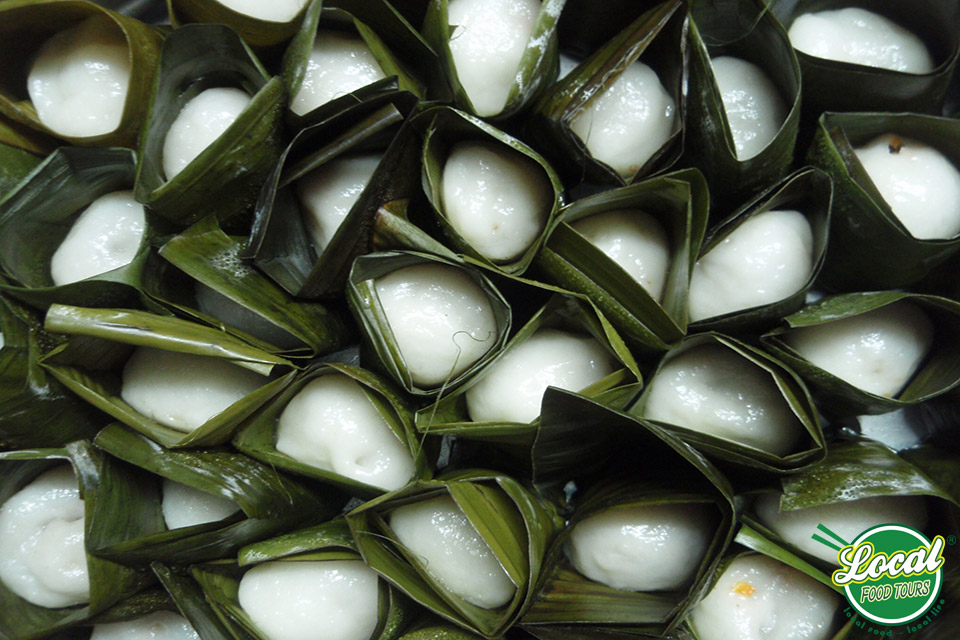Banh dom is a kind of glutinous rice flour cake with bean paste which is the common and rustic cake in the North of Vietnam. Nonetheless, in Phu Nhi Village, this cake had been a noble cake which was offered the emperor.

The Rustic Cake In The Royal Palace Kitchen
As a Hanoi traditional food, banh dom is not an unfamiliar fare to the Northern people. However, the most delicious is made in the Midlands thanks to the type of fragrant glutinous rice cultivated here.
The village that is the most famous for making this cake is Phu Nhi village in Son Tay Town. Banh dom in Phu Nhi village has the shrimp in the fillings, which makes it distinguished from any other types of banh dom in the North. In the past, this cake was the gift to the emperor every year.
It is said that under the reign of Emperor Le Thanh Tong, the folks lived in peace; therefore, they greatly respect the emperor who was the wholehearted leader of the country. Besides controlling the government, Emperor Le Thanh Tong also cared about the life of the civilians and severely punished the embezzlers or corrupt officials. Le Thanh Tong was also the emperor that helped Vietnamese Literature develop and become the elegant art by establishing the literary coterie.
One day, the emperor wanted to know if the officials cared for the life of the people in their hometown or not, so he gave all the officials a question. The question was that each person had to make a course which was the simple and rustic dish of their hometown. They had to make the dish in the palace kitchen without using any luxury ingredients. The result of this strange examination was judged by the emperor, the royal cooks and some people of the literary coterie. Most of the officials came from the noble families, so they did not know anything about the cookery.
Many dishes of them were blasted by the judge and failed. There were some delicious dishes, yet they were not the traditional dishes of their hometown. Therefore, their dishes also failed.
Among the officials, there is a bachelor from Phu Nhi village in Son Tay. He was born in a poor family who lived on the money from selling cakes. When he was young, he had to help his mother to make cakes. Recalling the difficult childhood, he used rice, mung beans, shrimp and banana leaves to make the cakes which help to pay for his schooling. The emperor and the judge all praised his cooking and the delicious cakes. This bachelor was prized. Since then, on the 10th of lunar October when people celebrate the new crops of rice, Phu Nhi villagers had made banh dom to worship the ancestors and offer the emperor.
Nowadays, although banh dom is not a royal gift anymore, it is still favored whenever referring to Hanoi local food tours.
The delicate processing
The cake wrapper is made of glutinous rice which contains Nep Cai Hoa Vang rice and Du Huong rice. The rice is soaked overnight and then ground with water by stone grinder until becoming the soft dough. The dough is drained on a piece of cheesecloth.
The bacon is diced into pieces as small as the point of the chopstick. The head and tail of the shrimp are cut off. The body shells are pilled. Shallot and black fungus mushroom are chopped after be soaked in the water. Bacon, shrimp, shallot and fungus mushroom are stir-fried with pure fish sauce, pepper and belostomatidae essence to make the fillings.
The maker spread a thin layer of dough in their palms to cover the small scoop of fillings inside. Then they roll the cake in their hands and press to make it flat and round. The banana leaves are greased with oil then used to wrap the cakes. Banh dom is steamed in a steamer. When the cakes are done, the wrapper is translucent enough to see the attractive fillings inside.
The white cakes hidden in the green leaves are sold in many places. Just join any food walking tour in the North, you also can find this tasty chewy cake.

